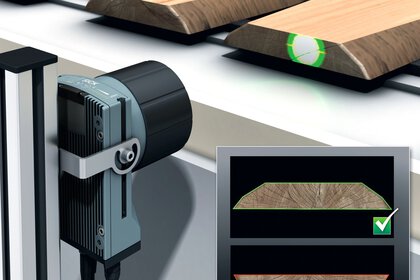Machine Vision as an AI Pioneer
Industrial machine vision is well advanced when it comes to the use of artificial intelligence (AI) and in particular with respect to deep learning. Vision experts also know the limits of the AI approach.
The fact that industrial machine vision is an AI pioneer is on the one hand due to the fact that vision experts have always been involved in pattern recognition. On the other hand, however, it is also due to the fact that image recognition is generally a popular field of activity for AI experts. For example, Google's AI camera software Google Lens detects a billion objects through the smartphone camera in the meantime and can then automatically assign them.
“Artificial intelligence has long been used in industrial machine vision,” Dr. Maximilian Lückenhaus confirmed, Marketing + Business Development Director at the vision software specialist MVTec Software. Deep learning, usually based on Convolutional Neural Networks (CNN), is of particular importance here. “These CNNs are artificial neural networks inspired by biological processes. They use very large amounts of digital image data for a comprehensive training process to be able to classify new objects independently afterward,” Dr. Lückenhaus explained.
Pre-trained deep learning tools
Specific features and characteristics of objects are automatically learned in this training process. After this training, new image data can be assigned and consequently particularly high and robust recognition rates can be achieved. Preferred areas of application: classification and object detection.
In order for companies to take advantage of the technology as easily as possible, Mvtec provides pre-trained deep learning tools in its software, which have been pre-trained based on approx. three million carefully selected images from the industrial environment. “Companies therefore only need comparatively few images of their own to train the networks in a way that is adapted to their applications,” Dr. Lückenhaus explained.
Cognex has also integrated deep learning-based image analysis tools into its software. The US vision specialists acquired the technology for this with the acquisition of Swiss Vidi Systems. “If people can learn to test products, Visionpro Vidi can do the same,” Joerg Kuechen emphasized, Senior Vice President of Image Processing Products at Cognex: “In addition, Visionpro Vidi can be trained with only 50 images in just a few minutes.”
Deep learning technology is especially a good complement when complicated testing procedures are needed for manufacturing processes that are time-consuming and difficult to program with conventional rule-based image processing, Mr. Cognex stressed. In addition, this also makes it possible for people who are not programming experts to maintain and retrain factory-level machine vision applications.
AI software needs customer data
Sick also relies on sensor solutions that work based on deep learning algorithms. “The goal is to use AI to enable a sensor to perform its task even better in the respective application,” Bernhard Müller explained, Industry 4.0 Vice President. His argument: Standard sensors are already doing their job very well, but when a new task is added, the sensors reach their limits. “On the other hand, a sensor can learn from experience and anticipate with AI: What's that I see? This creates a better sensor that can also detect things it has never seen before.”
Instead of using pre-trained AI networks, Sick relies on individual customer projects. “For example, we are working on a camera pilot project with deep learning in the lumber industry,” Mr. Müller explained. Sawmills need to know the conditions in the log for optimum utilization of the raw material wood. Where are the annual rings, and where is the core? “We taught the camera with deep learning how the lumber can be best used. This is a task that previously could only be done by people,” Mr. Müller stated. Close interaction with the customer is important here. “The topic of AI cannot be implemented without the customer. He should therefore provide concrete example data with which the AI sensor can learn, because AI needs appropriate training data.”
Error rate greatly reduced in practice
Mvtec has also worked closely with pilot customers from various industries to develop the deep learning features of its Halcon software. With success: When testing contact surfaces, the implementation of deep learning-based error detection resulted in a massive reduction in the error rate, which drastically reduced the need for manual testing and accelerated production.
As a result, everything is good thanks to deep learning? “The technology provides many advantages, but also has limitations,” Dr. Lückenhaus said. On the one hand, hundreds of thousands of sample images are required for training, especially when using open-source solutions. On the other hand, the training and also the later AI-based classification of the data require a great deal of computing resources. “Consequently, large computing capacities and corresponding hardware are required. A standard CPU is usually not sufficient in very time-critical applications,” Dr. Lückenhaus emphasized.
Industrial camera manufacturers like IDS are reacting to this. In their app-based industrial cameras, the camera CPU is supported by a programmable special chip, a Field Programmable Gate Array (FPGA). That is why IDS has now developed an AI vision app that transforms the integrated FPGA into an AI processor that can accelerate the execution of many known neural network architectures.

